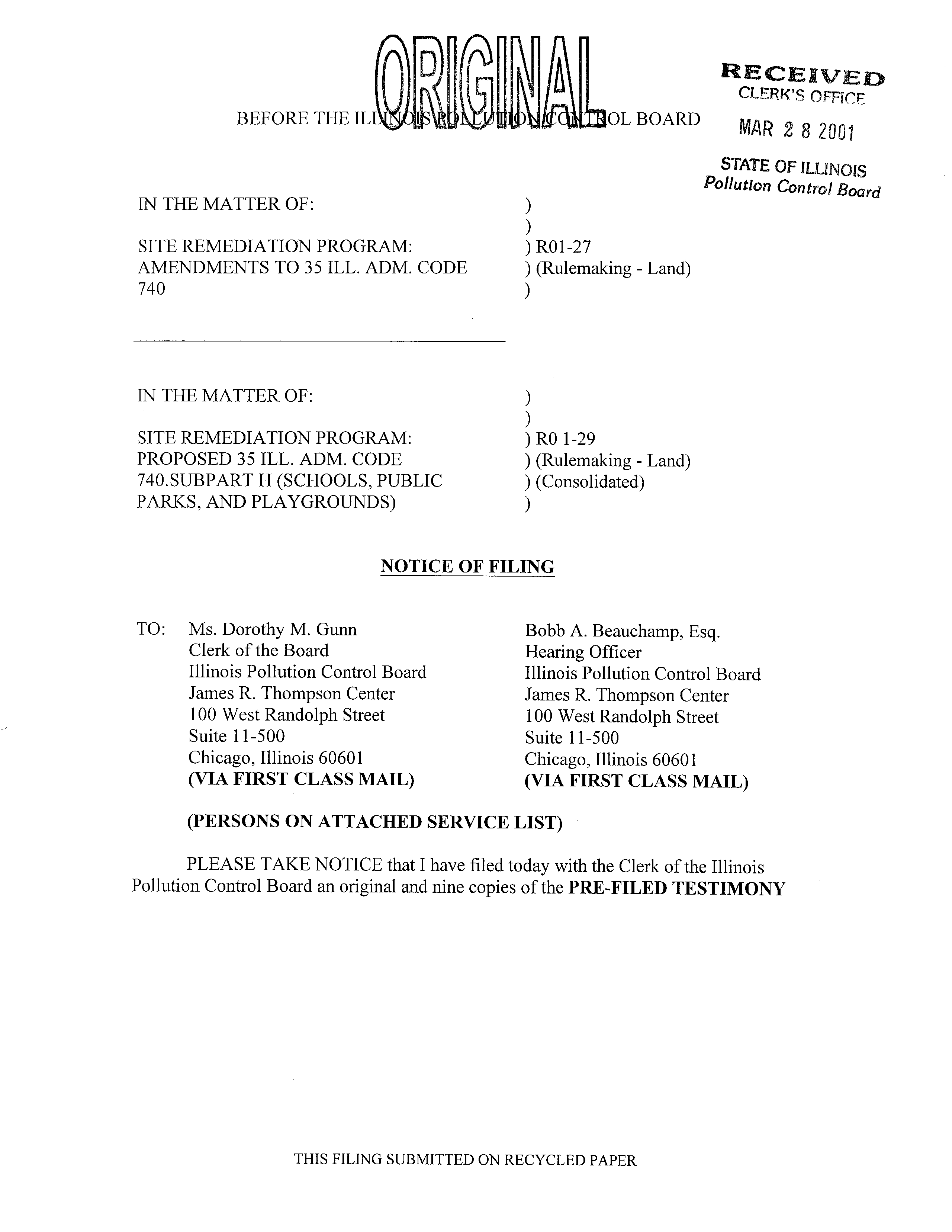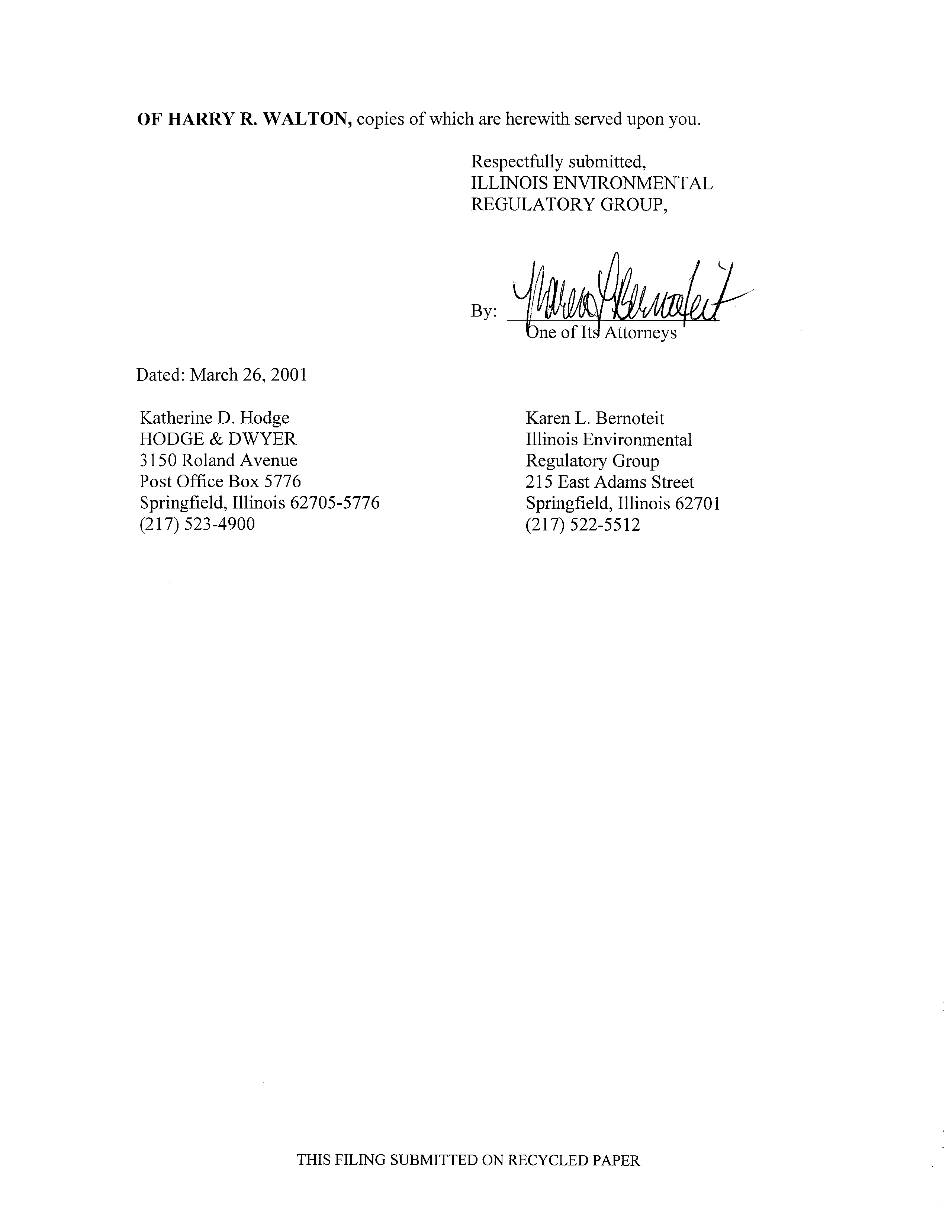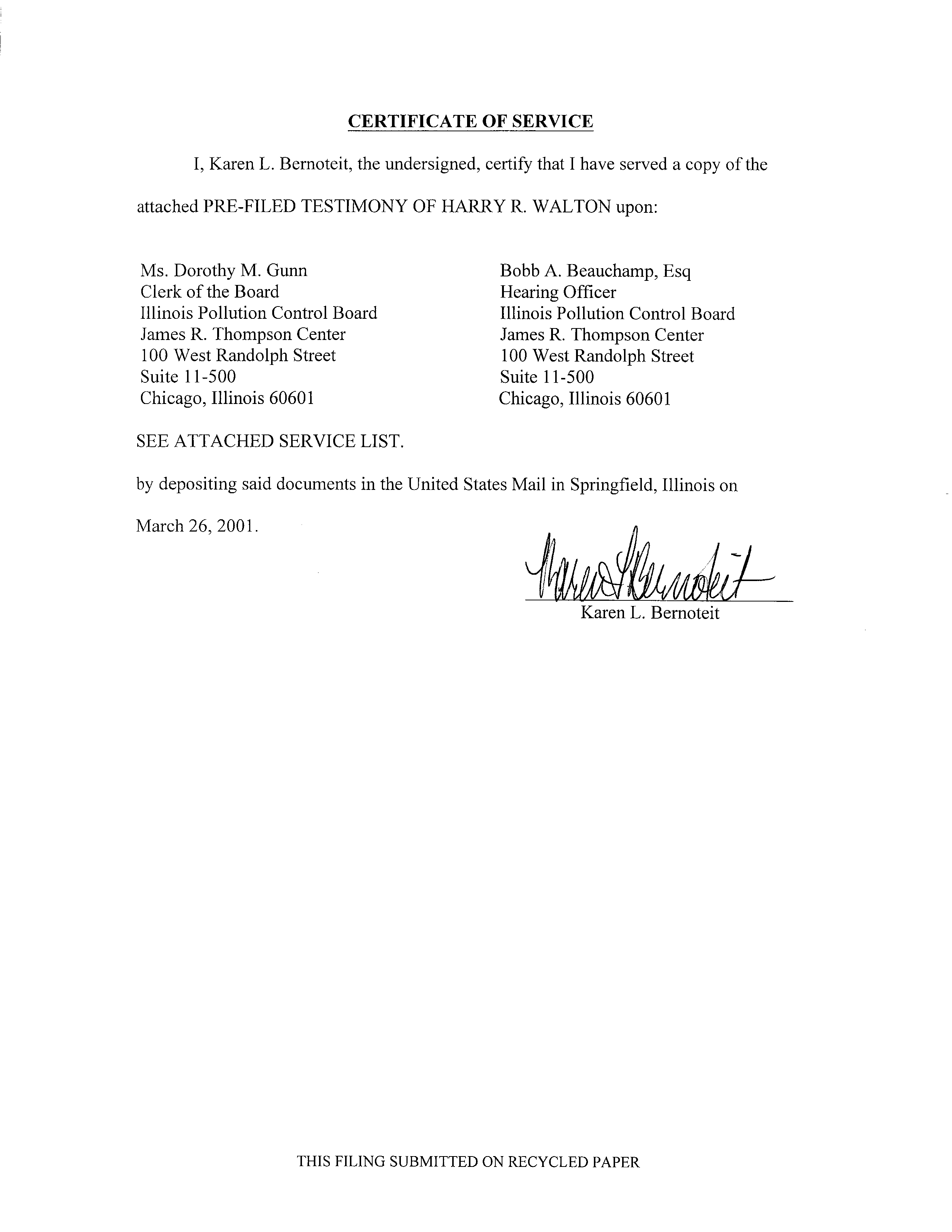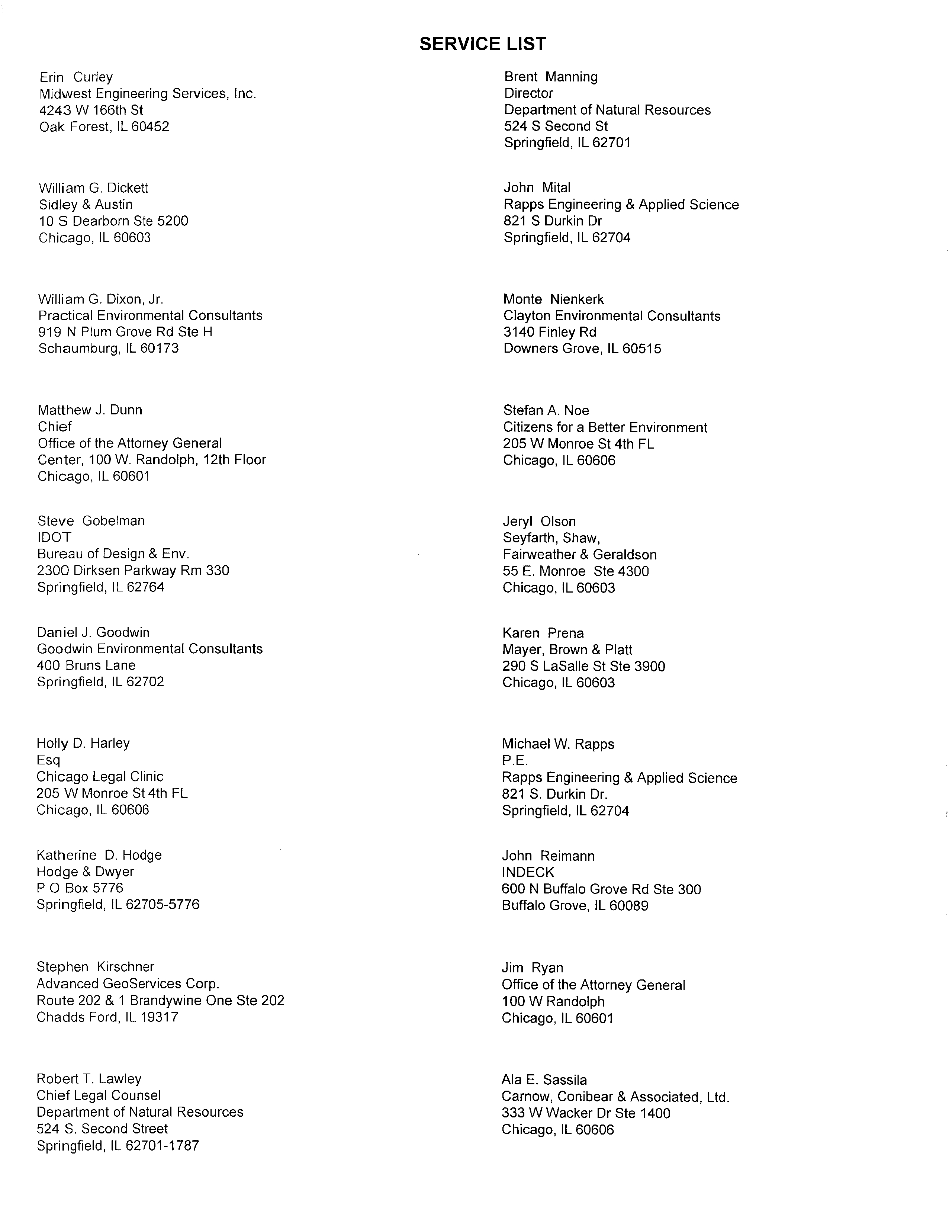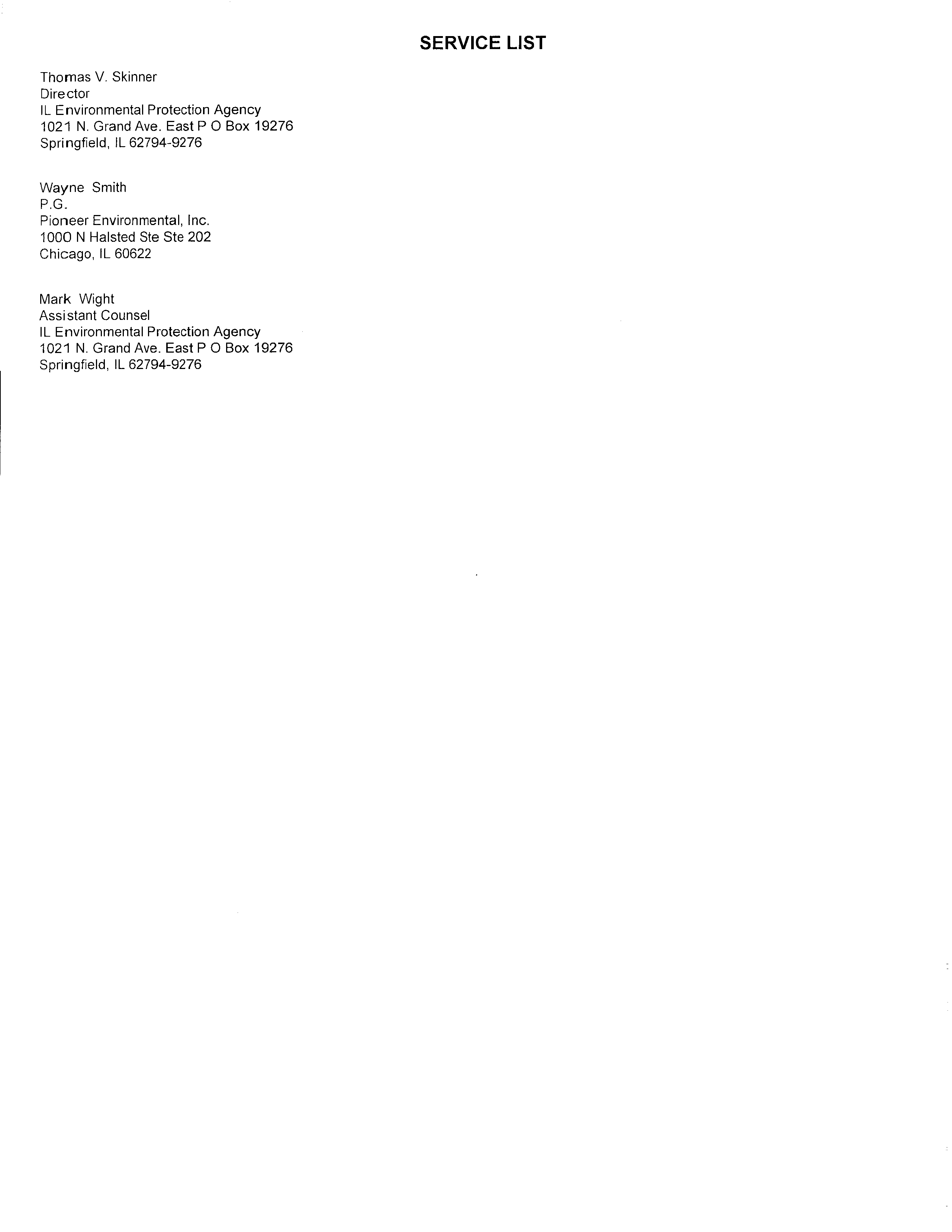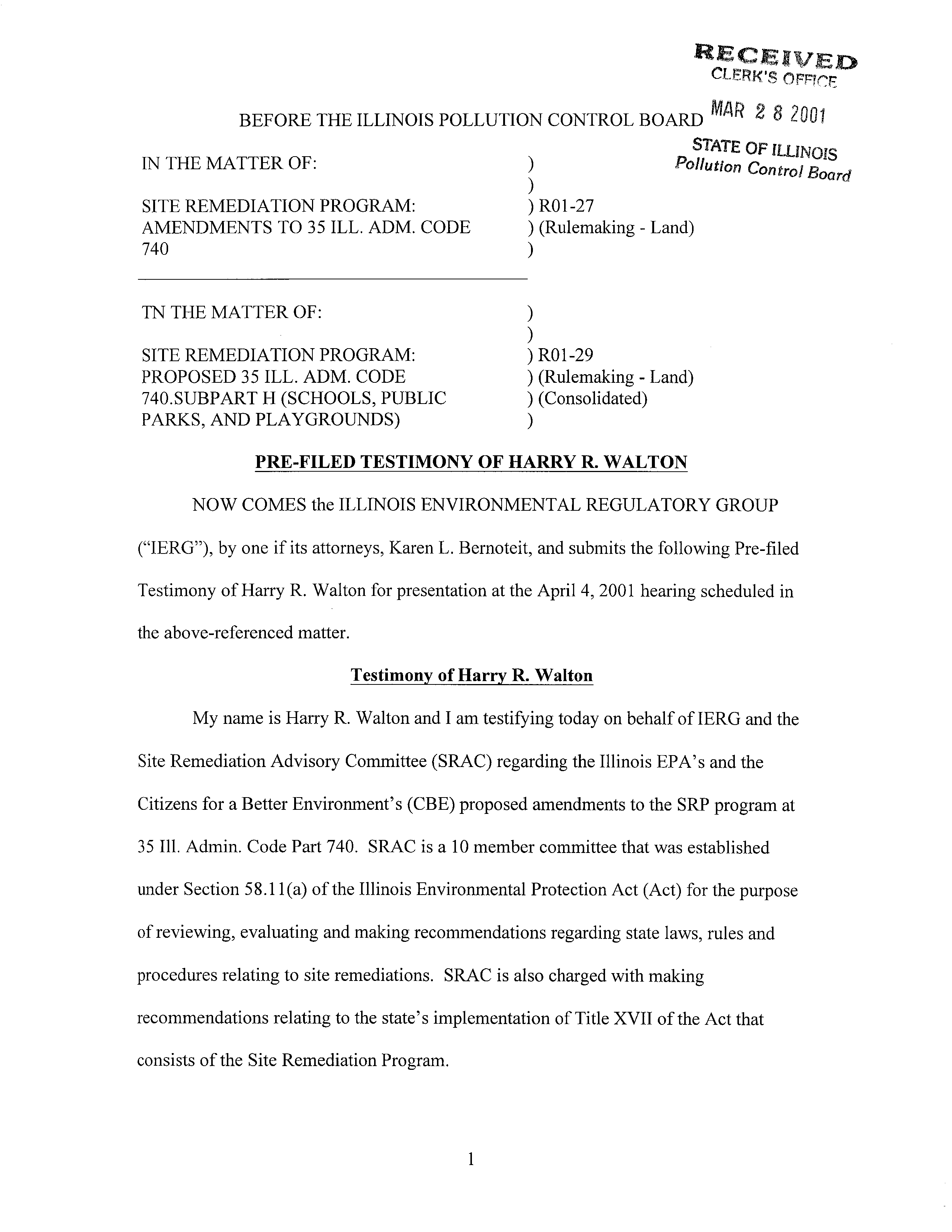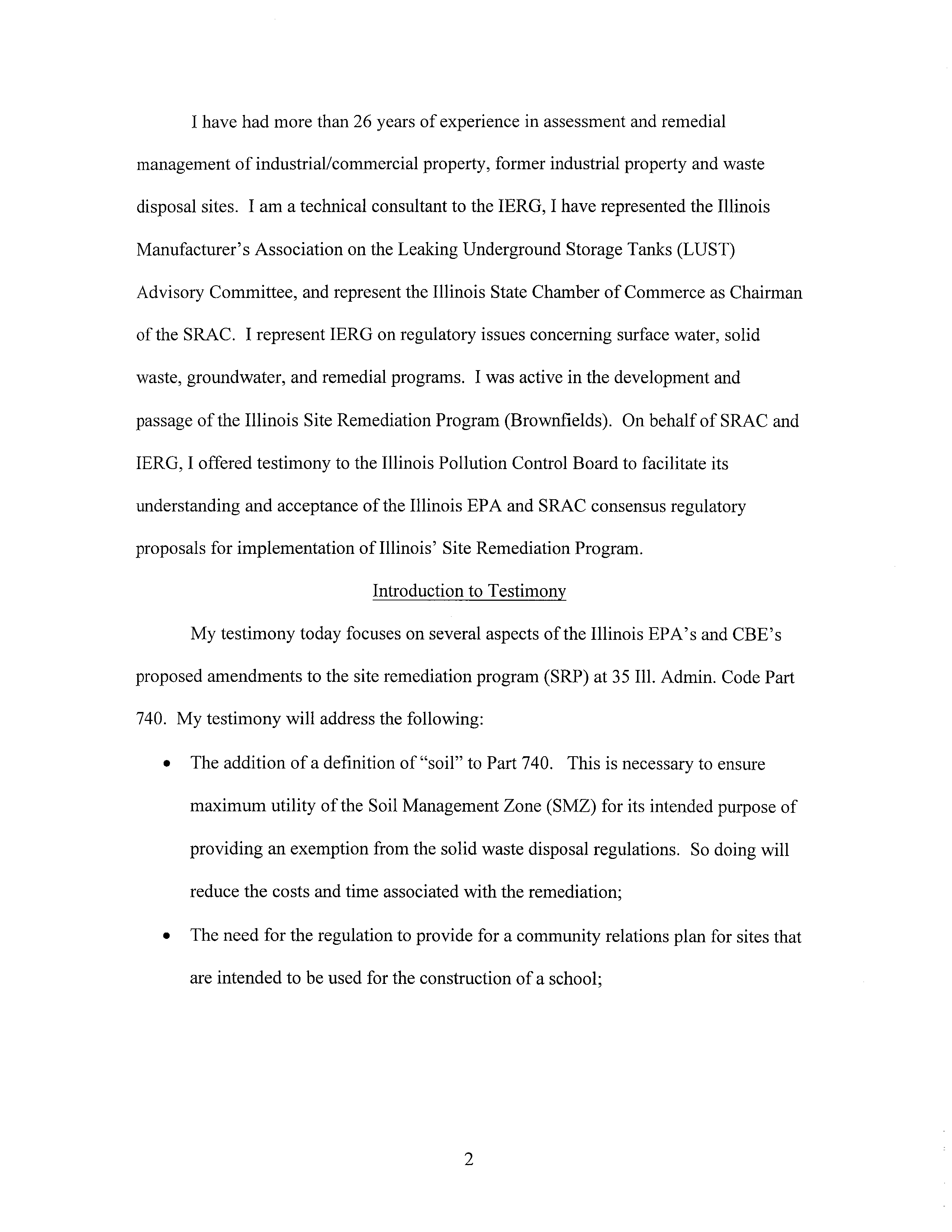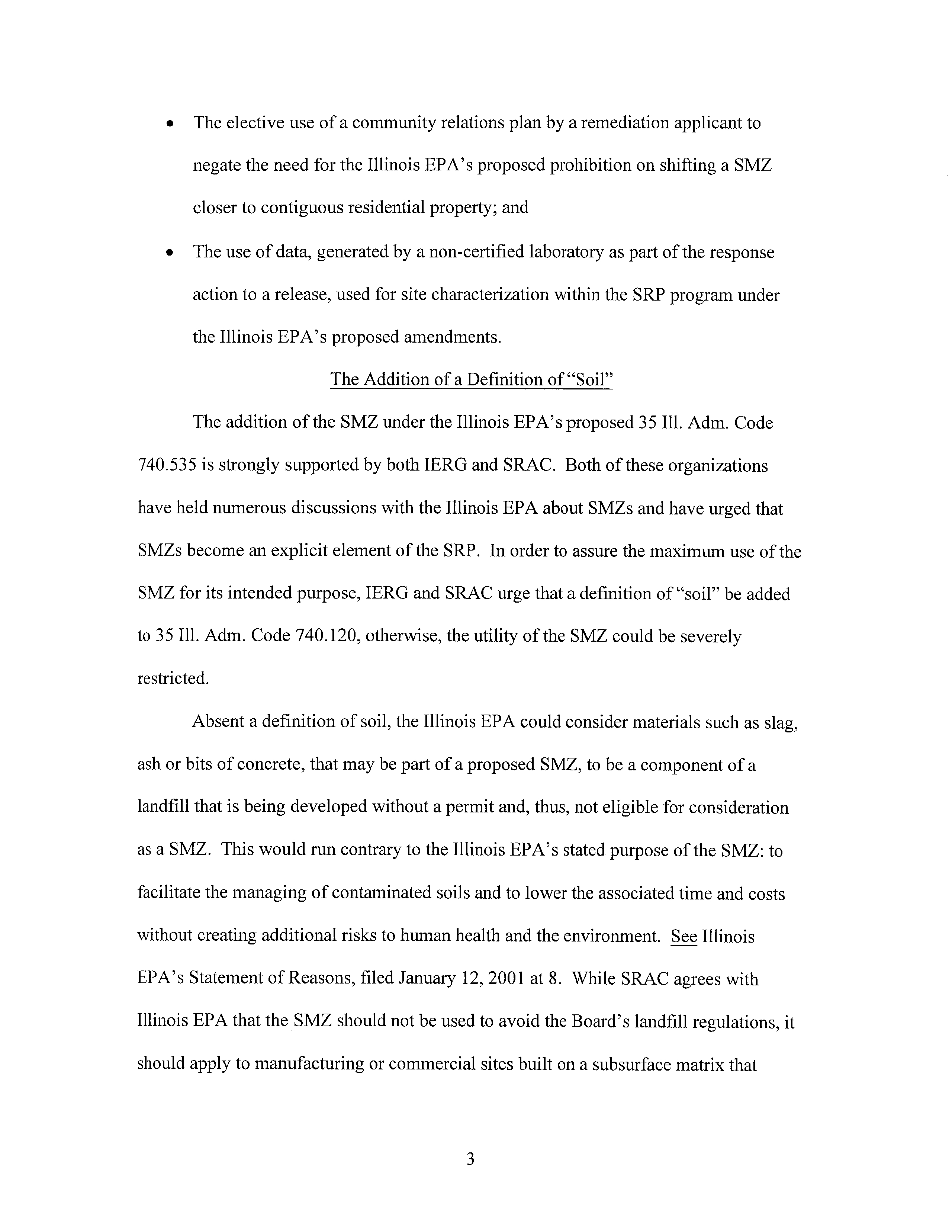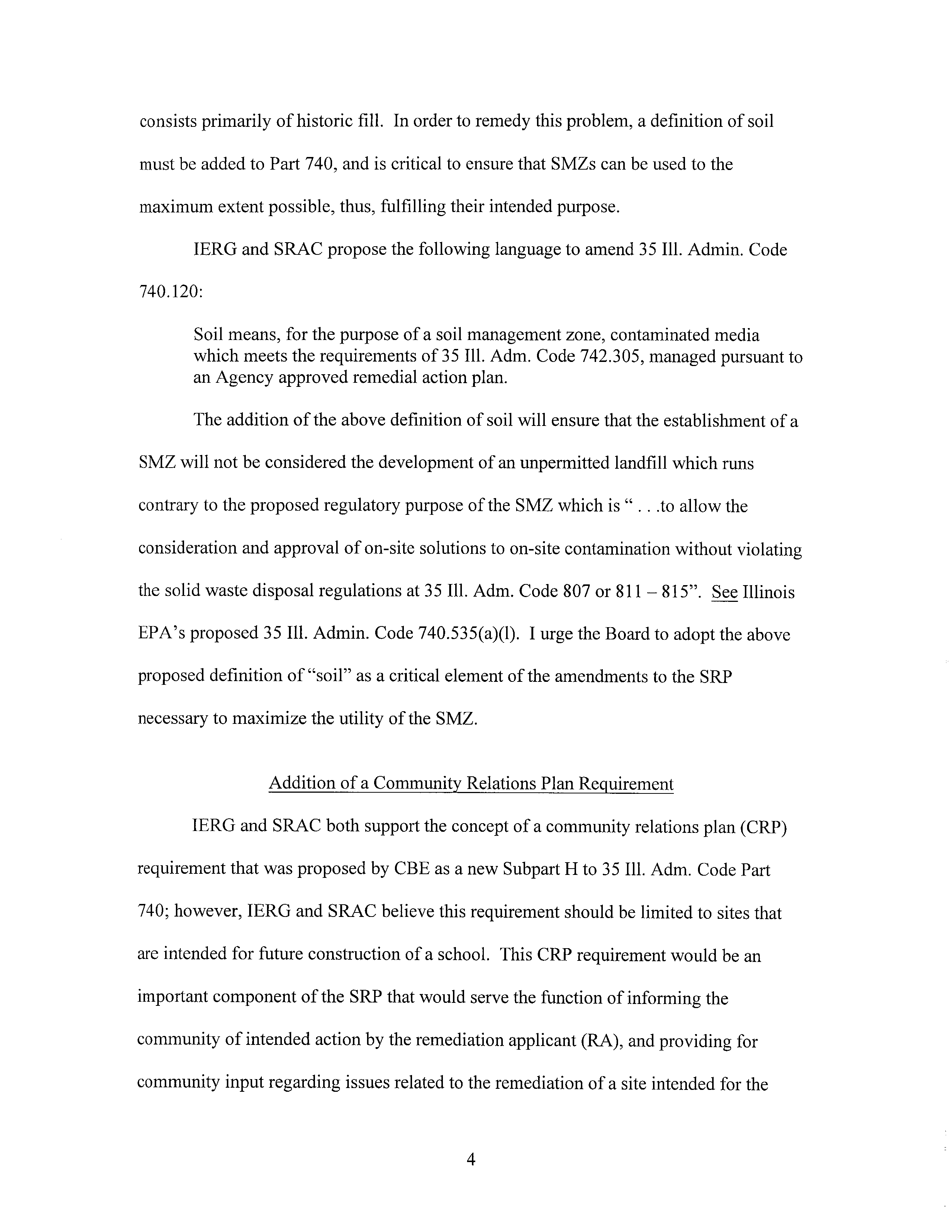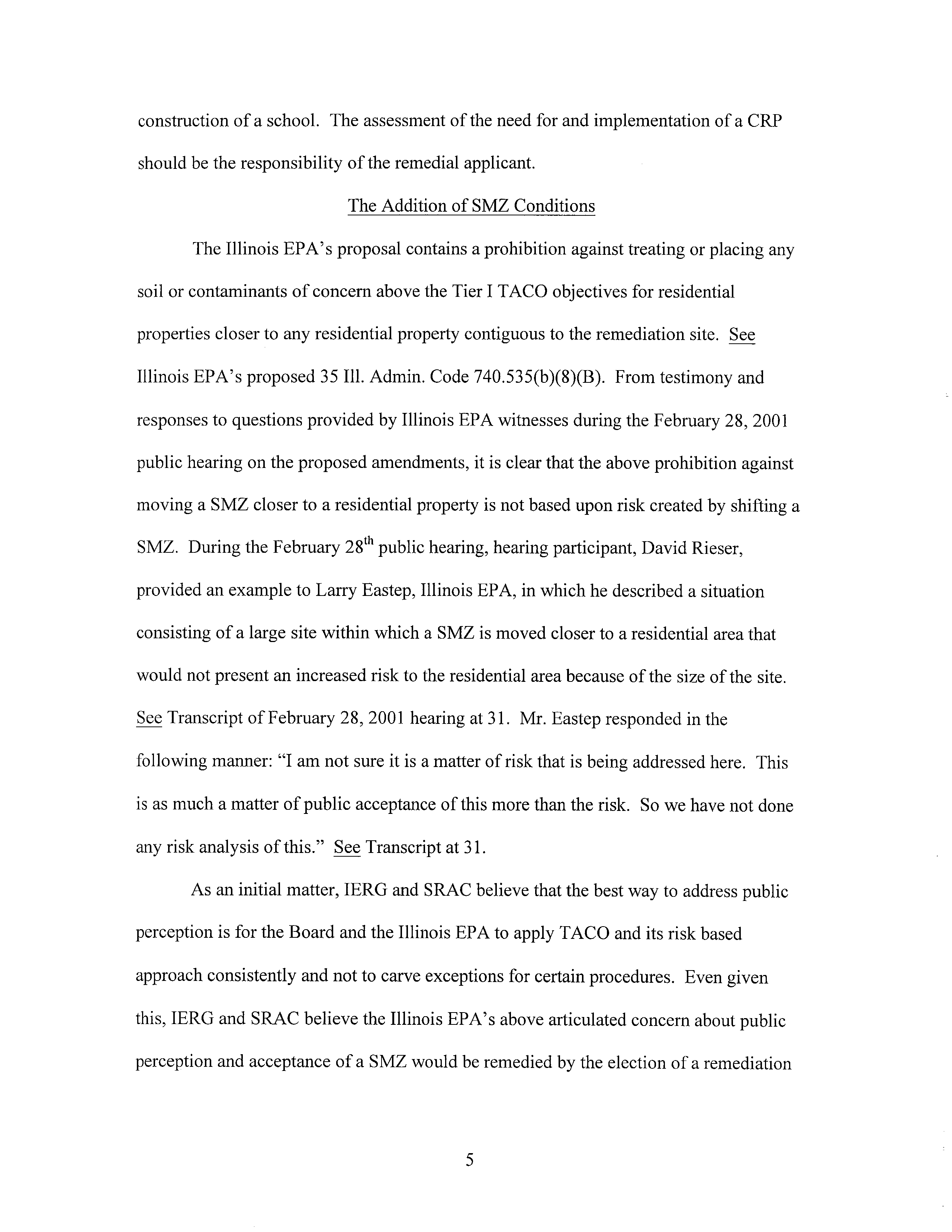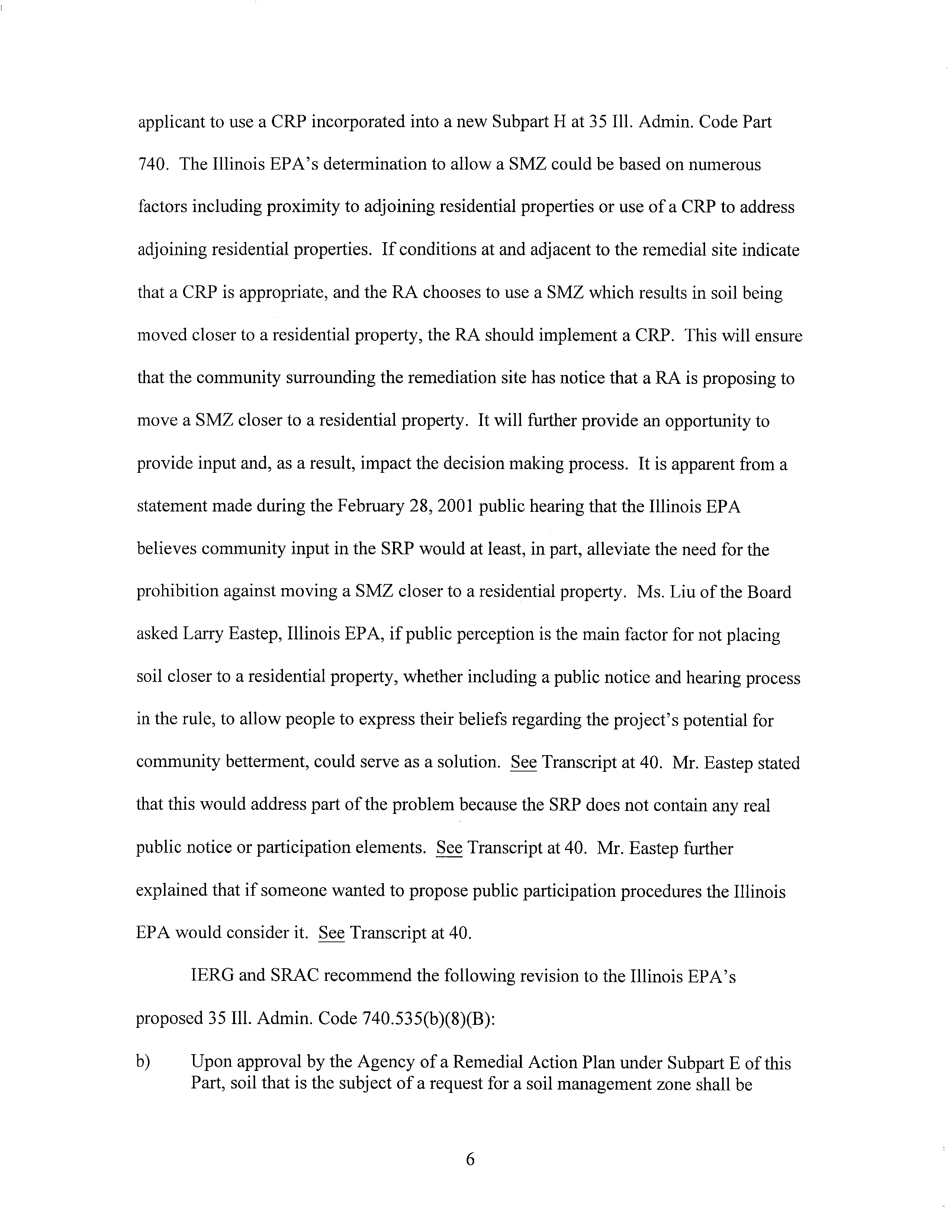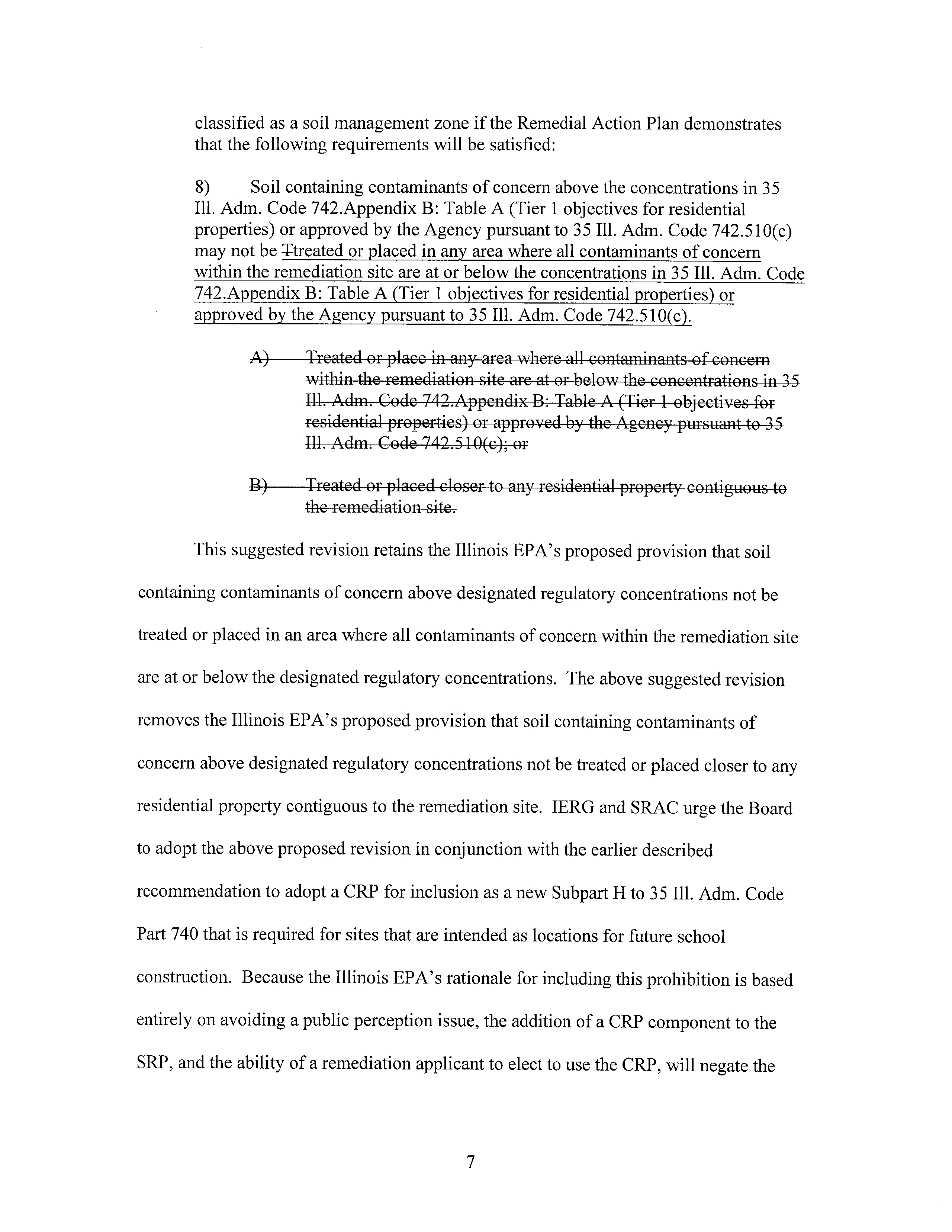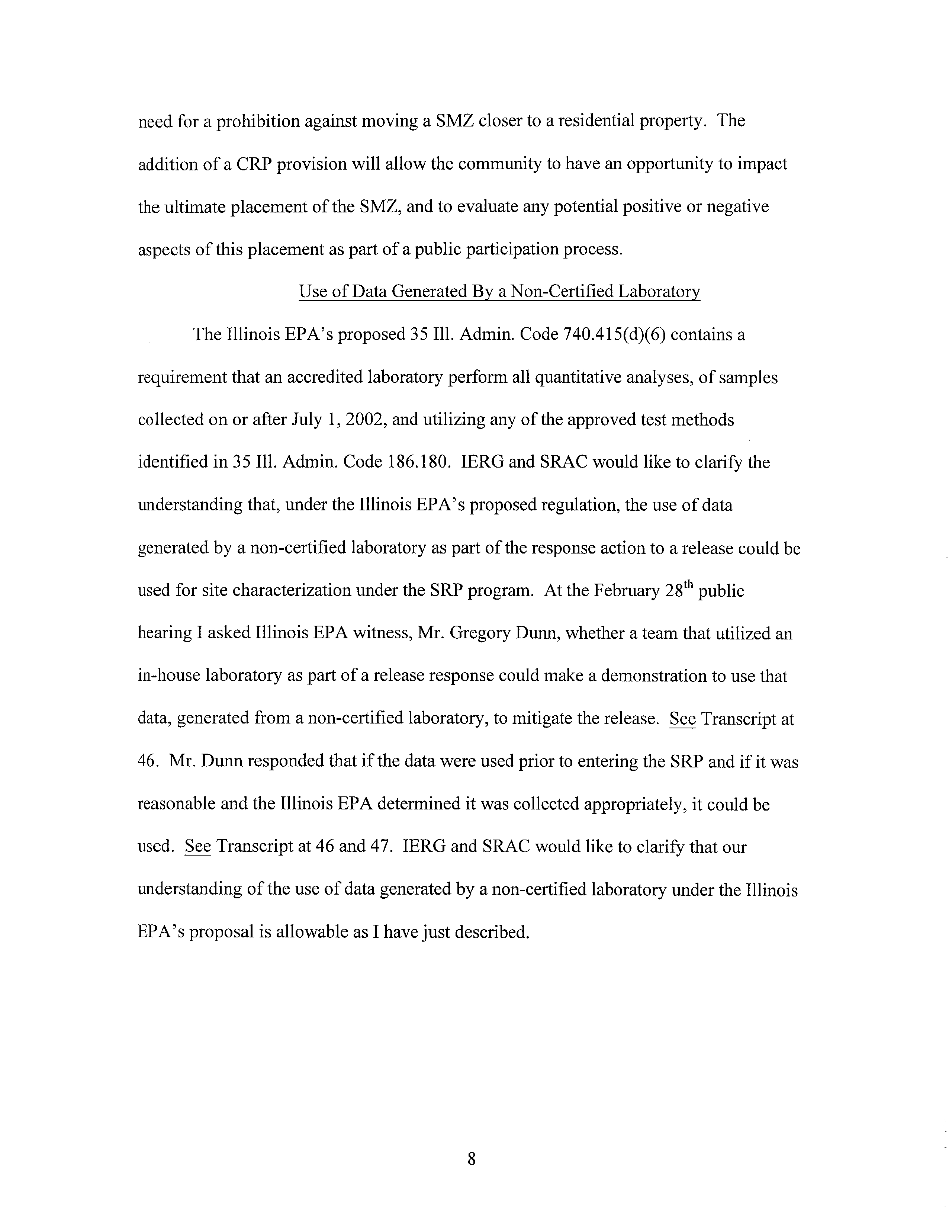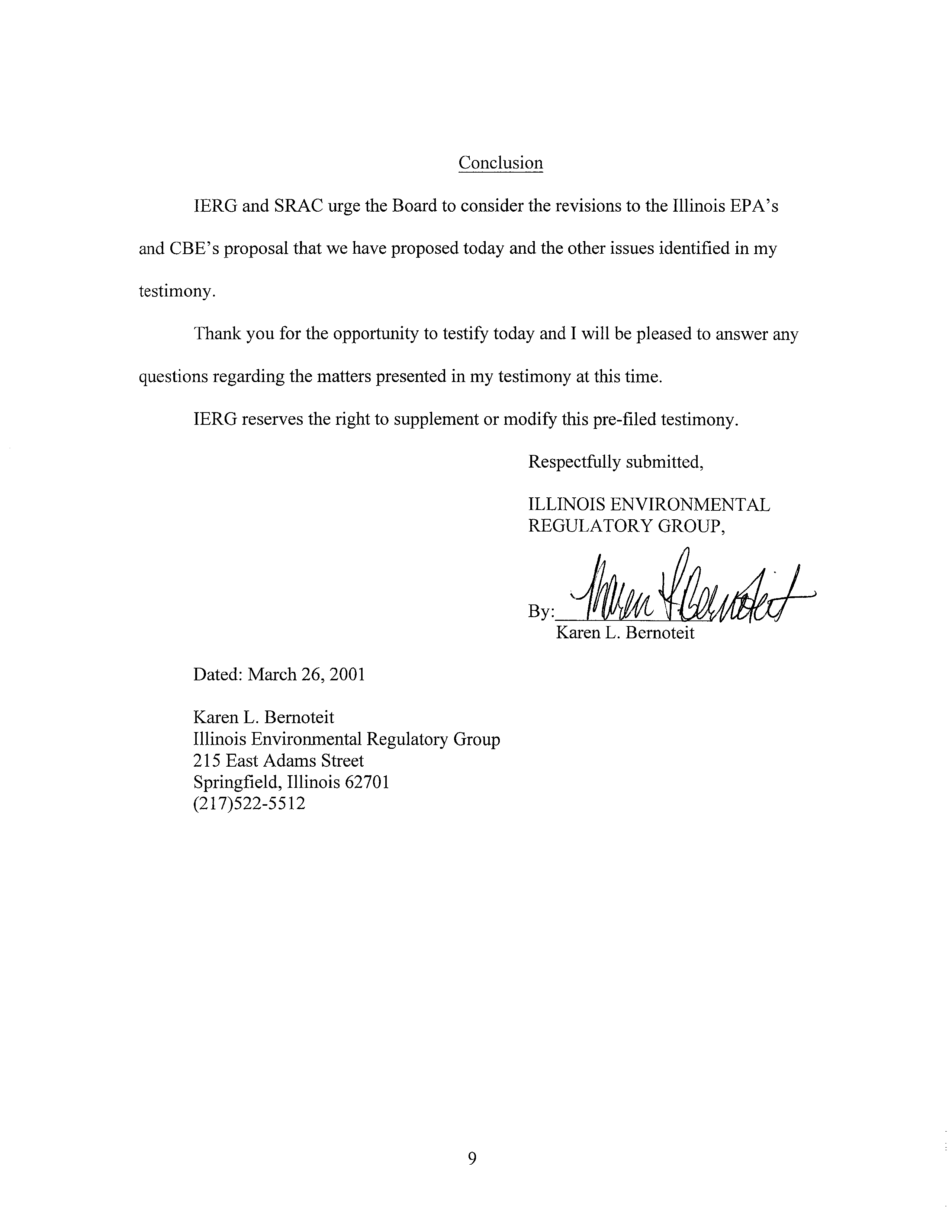BEFORE THE IL
OL BOARD
IN THE MATTER OF:
RE Clii
VE U
CLFRK’S
OFF
c~
MAR
2
8
2001
STATE OF ILL NO~s
Pollutior, Control Board
)
SITE REMEDIATION PROGRAM:
AMENDMENTS TO
35
ILL. ADM. CODE
740
)
)
ROl-27
)
(Rulemaking
-
Land)
)
IN THE MATTER OF:
SITE REMEDIATION PROGRAM:
PROPOSED
35
ILL. ADM. CODE
740.SUBPART H (SCHOOLS, PUBLIC
PARKS, AND PLAYGROUNDS)
)
)
RO
1-29
)
(Rulemaking
-
Land)
)
(Consolidated)
)
NOTICE OF FILING
TO:
Ms.
Dorothy M. Gunn
Clerk of the Board
Illinois Pollution Control Board
James R. Thompson Center
100 West Randolph Street
Suite 11-500
Chicago, Illinois 60601
(VIA FIRST CLASS MAIL)
Bobb A. Beauchamp, Esq.
Hearing Officer
Illinois Pollution Control Board
James
R. Thompson Center
100 West Randolph Street
Suite
11-500
Chicago, Illinois 60601
(VIA FIRST CLASS MAIL)
(PERSONS
ON ATTACHED SERVICE LIST)
PLEASE TAKE NOTICE that I have filed today with the Clerk ofthe Illinois
Pollution Control Board an original and nine copies of the
PRE-FILED TESTIMONY
)
THIS FILING
SUBMITTED ON RECYCLED PAPER
OF HARRY R. WALTON,
copies of which are herewith served upon you.
Respectfully submitted,
ILLINOIS ENVIRONMENTAL
REGULATORY GROUP,
By:
ne ofIt
Dated: March 26, 2001
Katherine D. Hodge
HODGE & DWYER
3150 Roland Avenue
Post Office Box 5776
Springfield, Illinois
62705-5776
(217) 523-4900
Karen L.
Bernoteit
Illinois Environmental
Regulatory Group
215 East Adams Street
Springfield, Illinois 62701
(217) 522-5512
THIS FILING SUBMITTED ON RECYCLED PAPER
CERTIFICATE OF SERVICE
I, Karen L. Bernoteit, the undersigned,
certify that I have served a copy ofthe
attached PRE-FILED TESTIMONY OF HARRY
R.
WALTON upon:
Ms.
Dorothy M. Gunn
Clerk of the Board
Illinois Pollution Control Board
James
R. Thompson Center
100 West Randolph Street
Suite 11-500
Chicago, Illinois 60601
Bobb A. Beauchamp, Esq
Hearing Officer
Illinois Pollution Control Board
James R.
Thompson Center
100 West Randolph Street
Suite
11-500
Chicago, Illinois 60601
SEE ATTACHED SERVICE LIST.
by depositing said documents
in the United States Mail in
Springfield, Illinois on
March 26, 2001.
Karen L Bernoteit
THIS FILING SUBMITTED ON RECYCLED PAPER
SERVICE LIST
Erin
Curley
Midwest Engineering
Services,
Inc.
4243 W
166th
St
Oak
Forest,
IL 60452
William
G.
Dickett
Sidiey & Austin
10
S
Dearborn
Ste 5200
Chicago,
IL 60603
William
G. Dixon, Jr.
Practical Environmental Consultants
919
N
Plum Grove
Rd
Ste
H
Schaumburg,
IL 60173
Matthew
J.
Dunn
Chief
Office of the Attorney General
Center, 100W. Randolph,
12th Floor
Chicago,
IL 60601
Steve
Gobelman
DOT
Bureau of Design
& Env.
2300 Dirksen
Parkway Rm 330
Springfield,
IL
62764
Daniel
J. Goodwin
Goodwin Environmental Consultants
400 Bruns
Lane
Springfield,
IL
62702
Holly D.
Harley
Esq
Chicago Legal
Clinic
205 W Monroe St 4th
FL
Chicago, IL
60606
Katherine
D.
Hodge
Hodge
& Dwyer
P 0
Box 5776
Springfield,
IL 62705-5776
Stephen Kirschner
Advanced GeoServices
Corp.
Route 202 &
1
Brandywine One Ste 202
Chadds
Ford,
IL
19317
Robert T. Lawley
Chief Legal
Counsel
Department of Natural
Resources
524 5. Second Street
Springfield,
IL 62701-1 787
Brent
Manning
Director
Department of Natural
Resources
524 5 Second St
Springfield,
IL 62701
John
Mital
Rapps Engineering
& Applied Science
821
5 Durkin Dr
Springfield,
IL
62704
Monte
Nienkerk
Clayton
Environmental Consultants
3140
Finley
Rd
Downers Grove,
IL 60515
Stefan A.
Noe
Citizens for
a Better Environment
205 W Monroe St 4th FL
Chicago,
IL
60606
Jeryl
Olson
Seyfarth, Shaw,
Fairweather
& Geraldson
55
E. Monroe
Ste 4300
Chicago, IL
60603
Karen
Prena
Mayer, Brown &
Platt
290 5 LaSalle
St Ste
3900
Chicago,
IL
60603
Michael W.
Rapps
PE.
Rapps Engineering & Applied
Science
821
5.
Durkin Dr.
Springfield,
IL 62704
John
Reimann
IN DECK
600
N Buffalo
Grove
Rd Ste
300
Buffalo
Grove, IL 60089
Jim
Ryan
Office
of the Attorney
General
100 W Randolph
Chicago,
IL 60601
Ala
E. Sassila
Carnow,
Conibear & Associated,
Ltd.
333 WWacker Dr Ste
1400
Chicago,
IL 60606
SERVICE LIST
Thomas V.
Skinner
Director
IL Environmental Protection Agency
1021
N.
Grand Ave.
East P 0
Box
19276
Springfield,
IL 62794-9276
Wayne
Smith
PG.
Pioneer Environmental,
Inc.
1000
N
Halsted Ste Ste 202
Chicago,
IL 60622
Mark
Wight
Assistant Counsel
IL
Environmental Protection Agency
1021
N. Grand Ave.
East P 0 Box
19276
Springfield,
IL 62794-9276
CLERI=’~
~WP~
~
M/i~~
2
8
2001
BEFORE THE ILLINOIS POLLUTION CONTROL BOARD
STATE OF ILLINOIS
IN THE MATTER
OF:
)
~~llUtiOn
Control Board
)
SITE REMEDIATION PROGRAM:
)
ROl-27
AMENDMENTS TO
35
ILL. ADM. CODE
)
(Rulemaking
-
Land)
740
)
TN THE MATTER OF:
)
)
SITE REMEDIATION PROGRAM:
)
ROl-29
PROPOSED
35
ILL. ADM. CODE
)
(Rulemaking
-
Land)
740.SUBPART H (SCHOOLS, PUBLIC
)
(Consolidated)
PARKS, AND PLAYGROUNDS)
)
PRE-FILED TESTIMONY OF HARRY R. WALTON
NOW COMES the ILLINOIS ENVIRONMENTAL REGULATORY GROUP
(“IERG”),by
one if its attorneys, Karen L. Bernoteit, and
submits the following Pre-filed
Testimony of Harry R.
Walton for presentation at the April 4, 2001 hearing scheduled in
the above-referenced matter.
Testimony of Harry R. Walton
My name is Harry R.
Walton and I am testifying today on behalfof IERG and the
Site Remediation Advisory Con-imittee (SRAC) regarding the Illinois EPA’sand the
Citizens for a Better Environment’s(CBE) proposed amendments to the SRP program at
35111.
Admin. Code Part 740.
SRAC is a 10 member committee that was established
under
Section
58.11(a)
of the Illinois Environmental Protection Act (Act) for the purpose
ofreviewing, evaluating and making recommendations regarding state laws, rules and
procedures relating to site remediations.
SRAC is also charged with making
recommendations relating to the state’s implementation of Title XVII ofthe Act that
consists ofthe Site Remediation Program.
1
I have had more than 26 years of experience in assessment and remedial
management of industrial/commercial property, former industrial property and waste
disposal sites.
I am a technical consultant to the IERG, I have represented the Illinois
Manufacturer’sAssociation on the Leaking Underground Storage Tanks (LUST)
Advisory Committee, and
represent the Illinois State Chamber of Commerce as Chairman
ofthe SRAC.
I represent IERG on regulatory issues concerning
surface water, solid
waste,
groundwater, and remedial programs.
I was active in the development and
passage of the Illinois
Site Remediation Program (Brownfields).
On behalfofSRAC and
IERG, I offered testimony to the Illinois Pollution Control Board to facilitate its
understanding and acceptance ofthe Illinois EPA and SRAC consensus regulatory
proposals for implementation of Illinois’ Site Remediation Program.
Introduction to Testimony
My testimony today focuses on several aspects of the Illinois EPA’sand CBE’s
proposed amendments to the site remediation program (SRP) at
35
Ill. Admin.
Code Part
740.
My testimony will address the following:
• The additionof a definition of“soil”to Part 740.
This is necessary to ensure
maximum utility ofthe
Soil Management Zone (SMZ) for its
intended purpose of
providing an exemption from the solid waste disposal
regulations.
So doing will
reduce the costs and time associated with the remediation;
• The need for the regulationtoprovide for a community relations plan for sites that
are intended to be used for the construction ofa school;
2
• The elective useof a community relations plan by a remediation applicant to
negate the need for the Illinois EPA’sproposed prohibition on shifting a SMZ
closer to contiguous residential property; and
• The useofdata, generated by a non-certified laboratory as part of the response
action to a release, used for site characterization within the SRP
program under
the Illinois
EPA’s proposedamendments.
The Addition ofa Definition of“Soil
The addition of the SMZ under the Illinois EPA’sproposed
35
Ill.
Adm. Code
740.535
is strongly supported by both JERO and SRAC.
Both of these organizations
have held nnmerous discussions with the Illinois EPA about SMZs and have urged that
SMZs become an
explicit element ofthe SRP.
In order to assure the maximum use ofthe
SMZ for its
intended purpose, IERG and SRAC
urge that a definition of“soil”be added
to
35
Ill. Adm.
Code 740.120, otherwise, the utility of the SMZ could be
severely
restricted.
Absent a definition of soil, the Illinois EPA could consider materials such as slag,
ash or bits of concrete, that may be part ofa proposed SMZ, to
be a component of a
landfill that
is being developed without a permit and, thus, not eligible for consideration
as a SMZ.
This would run contrary to
the Illinois EPA’s statedpurposeofthe SMZ:
to
facilitatethe managing of contaminated soils and to
lower the associated time and costs
without creating additional risks to human health and the environment.
See Illinois
EPA’s Statement of Reasons, filed January
12,
2001
at 8.
While SRAC agrees with
Illinois EPA that the SMZ should not be
used to
avoid the Board’slandfill regulations, it
should apply to manufacturing or commercial sites built
on a subsurface matrix that
3
consists primarily ofhistoric fill.
In order to remedy this problem, a definition of soil
must be added to Part 740, and is critical to ensure that SMZs can be
used to
the
maximum extent possible,
thus, fulfilling their intended purpose.
IERG and SRAC propose the following language to amend
35
Ill.
Admin.
Code
740.120:
Soil means, for the purpose ofa soil management zone, contaminated media
which meets the requirements of
35
Ill.
Adm. Code
742.305,
managed pursuant to
an Agency approved remedial action plan.
The addition ofthe above definition of soil will ensure that the establishment ofa
SMZ will not be considered the development ofan unpermitted landfill which runs
contrary to the proposed regulatory purpose ofthe SMZ which is”..
.to
allow the
consideration and approval ofon-site solutions to on-site contamination without violating
the solid waste disposal regulations at
35
Ill. Adm.
Code 807 or 811
—815”.
See Illinois
EPA’sproposed
35
Ill. Admin.
Code
740.535(a)(l).
I urge the Board to adopt the above
proposed definition of“soil” as acritical element ofthe amendments to the SRP
necessary to maximize the utility of the SMZ.
Addition of a Community Relations Plan Requirement
IERG and SRAC
both support the concept ofa community relations plan (CRP)
requirement that was proposed by CBE as a new Subpart H to
35
Ill. Adm.
Code Part
740; however, IERG and SRAC believe this
requirement should be limited to sites that
are intended for future construction ofa school.
This CRY requirement would be an
important component ofthe
SRP that would serve the function of informing the
community ofintended action by the remediation applicant (RA),
and providing for
community input regarding issues related to the remediation of a site intended for the
4
construction of a school.
The assessment ofthe need for and implementation of a CRY
should be the responsibility of the remedial applicant.
The Addition of SMZ Conditions
The Illinois EPA’s proposal contains a prohibition against treating or placingany
soil or contaminants ofconcern above the Tier I TACO objectives for residential
properties closer to any residential property contiguous to the remediation site.
See
Illinois EPA’s proposed
35
Ill.
Admin. Code
740.535(b)(8)(B).
From testimony and
responses to questions provided by Illinois EPA witnesses during the February 28, 2001
public hearing on the proposed amendments, it is clear that the above prohibition against
moving a SMZ closer to a residential property is not based upon risk created by shifting a
SMZ.
During the February 28~ public hearing, hearing participant, David Rieser,
provided an example to Larry Eastep, Illinois EPA, in which he described a situation
consisting ofa large site within which
a SMZ is moved closer to a residential area that
would not present an increased risk to the residential area because ofthe size ofthe site.
See Transcript of February 28, 2001
hearing at 31.
Mr. Eastep responded in the
following manner: “I am not sure it is a matter of risk that
is being addressed here.
This
is as much a matter of public acceptance ofthis more than the risk.
So we have not done
any risk analysis of this.”
See Transcript at 31.
As
an initial matter, IERG and SRAC believe that the best way to
address public
perception is for the Board and the Illinois EPA to apply TACO and
its risk based
approach consistently and not to carve exceptions for certain procedures.
Even given
this, IERG and SRAC believe the Illinois EPA’sabove articulated concern about public
perception and acceptance ofa SMZ would be remedied by the election ofa remediation
5
applicant to use a CRY incorporated into a new Subpart H at 35 Ill.
Admin. Code
Part
740.
The Illinois EPA’s determinationto allow a SMZ could be based on numerous
factors including proximity to adjoining residential properties or use of a CRY to address
adjoining residential properties.
Ifconditions
at
and adjacent to the remedial site indicate
that a CRY is appropriate, and the RA chooses to use a SMZ which results in soil being
moved closer to a residential property, the RA should implement a CRY.
This will ensure
that the community surrounding the remediation site has notice that a RA is proposing to
move a SMZ closer to
a residential property.
It will further provide an opportunity to
provide input and, as a result, impact the decision making process. It is apparent from a
statement made during the February 28, 2001
public hearing that the Illinois EPA
believes community input in the
SRY would at least, in part, alleviate the need for the
prohibition against moving a SMZ closer to a residential property.
Ms. Liu ofthe Board
asked Larry Eastep, Illinois
EPA, if public perception is the main factor for not placing
soil closer to a residential property, whether including a public notice and hearing process
in the rule, to
allow people to
express their beliefs regarding the project’spotential for
community betterment,
could serve as a solution.
See Transcript at 40.
Mr. Eastep stated
that this would address part ofthe problem because the SRY does not contain any real
public notice or participation elements.
See Transcript at 40.
Mr. Eastep further
explained that if someone wanted to propose public participation procedures the Illinois
EPA would
consider it.
See Transcript at 40.
IERG and SRAC recommend the following revision to the Illinois EPA’s
proposed 35 Ill.
Admin.
Code
740.535(b)(8)(B):
b) Upon approval by the Agency of a Remedial Action Plan under Subpart E of this
Part, soil that
is the subject ofa request for a soil management zone shall be
6
classified as a soil management zone if the Remedial Action Plan demonstrates
that the following requirements will be satisfied:
8)
Soil containing contaminants of concern above the concentrations in
35
Ill.
Adm. Code 742.Appendix
B: Table
A (Tier
1
objectives for residential
properties) or approved by the Agency pursuant to
35 Ill. Adm. Code
742.5
10(c)
may not be Ttreated or placed in any area where all contaminants of concern
within the remediation site are at or below the concentrations in 35
Ill. Adm. Code
742.Appendix B: Table A (Tier
1
objectives for residential properties) or
approved by the Agency pursuant to
35 Ill. Adm.
Code
742.510(c)
A)
Treated or place in
any area where all contaminants ofconcern
within the remediation site are at or below the concentrations in 35
Ill.
Adm. Code
712.Appendix B:
Table A (Tier
1
objectives for
residential properties) or approved by the Agency pursuant to
35
Ill.
Adm.
Code
712.510(c);
or
B)
Treated or placed closer to any residential property contiguous to
the remediation site
This
suggested revision retains the Illinois EPA’sproposed provision that soil
containing contaminants of concern above designated regulatory concentrations not be
treated or placed in an area where all contaminants ofconcern within the remediation site
are at or below the designated regulatory concentrations.
The above suggested revision
removes the Illinois EPA’sproposed provision that soil containing contaminants of
concern above
designated regulatory concentrations not be treated or placed closer to
any
residential property contiguous to the remediation site.
IERG and SRAC urge the Board
to adopt the above proposed revision in
conjunction with the earlier described
recommendation to adopt a CRY for inclusion as a new Subpart H to
35 Ill.
Adm. Code
Part 740 that
is required for sites that are intended as locations for future
school
construction.
Because the Illinois EPA’s rationale forincluding this prohibition is based
entirely on avoiding a public perception issue, the addition ofa CRY component to the
SRP,
and the ability ofa remediation applicant to
electto use the CRY, will negate the
7
need for a prohibition against moving a SMZ closer to a residential property.
The
addition ofa CRY provision will allow the community to have an opportunity to
impact
the ultimate placement ofthe SMZ, and to evaluate any potential positive or negative
aspects of this placement as part ofa public participation process.
Use of Data Generated By a Non-Certified Laboratory
The Illinois EPA’sproposed 35
Ill. Admin.
Code 740.415(d)(6) contains a
requirement that an
accredited laboratory perform all quantitative analyses, ofsamples
collected on or after July
1, 2002, and utilizing any of the approved test methods
identified in 35
Ill. Admin.
Code
186.180.
IERG and SRAC would like
to clarify the
understanding that, under the Illinois EPA’s proposed regulation, the use ofdata
generated by a non-certified laboratory as part of the response action to a release could
be
used for site characterization under the SRY program.
At the February
28th
public
hearing I asked Illinois EPA witness, Mr. Gregory Dunn, whether a team that utilized an
in-house laboratory as part of a release response could make a demonstration to
use that
data, generated from a non-certified laboratory, to mitigate the release.
See Transcript at
46.
Mr. Dunn responded that if the data were used prior to entering the SRY and if it was
reasonable and the Illinois EPA determined it was collected appropriately, it could be
used.
See Transcript at 46 and 47.
IERG and SRAC would like
to clarify that our
understanding ofthe use ofdata generated by a non-certified laboratory under the Illinois
EPA’sproposal
is allowable as I havejust described.
8
Conclusion
IERG and SRAC urge the Board to consider the revisions to the Illinois EPA’s
and CBE’sproposal that we have proposed today and the other issues identified in my
testimony.
Thank you for the opportunity to testify today and I will be pleased to answer any
questions regarding the matters presented in my testimony at this time.
IERG reserves the right to
supplement or modify this pre-filed testimony.
Respectfully submitted,
ILLINOIS ENVIRONMENTAL
REGULATORY GROUP,
By
Karen L. Bernoteit
Dated: March 26, 2001
Karen L. Bernoteit
Illinois
Environmental Regulatory Group
215 East Adams Street
Springfield,
Illinois 62701
(217)522-5512
9
